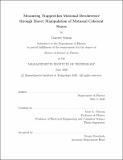| dc.contributor.advisor | Isaac L. Chuang. | en_US |
| dc.contributor.author | Simon, Garrett(Garrett Kenji) | en_US |
| dc.contributor.other | Massachusetts Institute of Technology. Department of Physics. | en_US |
| dc.date.accessioned | 2021-03-22T17:45:19Z | |
| dc.date.available | 2021-03-22T17:45:19Z | |
| dc.date.copyright | 2020 | en_US |
| dc.date.issued | 2020 | en_US |
| dc.identifier.uri | https://hdl.handle.net/1721.1/130221 | |
| dc.description | Thesis: S.M., Massachusetts Institute of Technology, Department of Physics, May, 2020 | en_US |
| dc.description | Cataloged from PDF version of thesis. | en_US |
| dc.description | Includes bibliographical references (pages 99-104). | en_US |
| dc.description.abstract | Trapped ions can serve as promising scalable qubits through the excitation of their internal electronic states with lasers to form an effective quantum two-level system, while the ion's quantized motional state in a harmonic potential well allows us to interact neighboring ions via the Coulomb force. As a result, high-fidelity operations require a precise knowledge of a system's motional decoherence time, or the time after which an ion's motional state is no longer reliably known or can no longer be controlled. Existing measurements of motional coherence indirectly control and measure the motional state by coupling the motional state to internal transitions driven by lasers, and as such, they may be prone to electronic state decoherence and laser amplitude or frequency fluctuations. In this thesis, we apply a previously-presented mechanism of direct electric field manipulation of a trapped ion motional coherent state in a novel free precession sequence to measure motional coherence times. This sequence consists of two coherent displacements with a variable phase difference in a continuous harmonic oscillator phase-space, separated by a variable delay time. Using a strontium-88⁺ ion trapped 50 micrometers above a niobium surface electrode trap in an ultra-high vacuum chamber at 4 Kelvin, we measure a motional decoherence rate of (24 ± 5) s⁻¹. This measured rate matches the expected decoherence rate for a system where trapped ion heating dominates other forms of decoherence in magnitude, which is likely the case for our system. | en_US |
| dc.description.statementofresponsibility | by Garrett Simon. | en_US |
| dc.format.extent | 104 pages | en_US |
| dc.language.iso | eng | en_US |
| dc.publisher | Massachusetts Institute of Technology | en_US |
| dc.rights | MIT theses may be protected by copyright. Please reuse MIT thesis content according to the MIT Libraries Permissions Policy, which is available through the URL provided. | en_US |
| dc.rights.uri | http://dspace.mit.edu/handle/1721.1/7582 | en_US |
| dc.subject | Physics. | en_US |
| dc.title | Measuring trapped-ion motional decoherence through direct manipulation of motional coherent states | en_US |
| dc.type | Thesis | en_US |
| dc.description.degree | S.M. | en_US |
| dc.contributor.department | Massachusetts Institute of Technology. Department of Physics | en_US |
| dc.identifier.oclc | 1241967066 | en_US |
| dc.description.collection | S.M. Massachusetts Institute of Technology, Department of Physics | en_US |
| dspace.imported | 2021-03-22T17:44:44Z | en_US |
| mit.thesis.degree | Master | en_US |
| mit.thesis.department | Phys | en_US |
